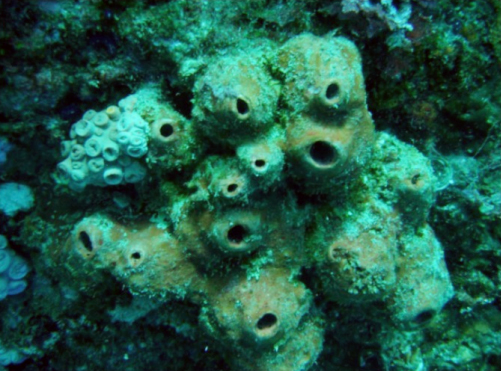Ocean sponge-dwelling bacteria have hidden talents. The kidney-red coral reef sponge, Theonella swinhoei, is a source of several anti-fungal and anti-cancer drug candidates. These compounds aren’t produced by the sponge itself, but by symbiotic bacteria that live inside it. The compounds in question are called polyketides, secondary metabolites that happen to be made by just two bacterial tenants of T. swinhoei, which have eluded researchers up to now.
Researchers from the Institute of Microbiology at ETH Zurich, Switzerland, working with the U.S. Department of Energy Joint Genome Institute (DOE JGI) and several other academic institutions used advanced sequencing methods to zero in on the bacteria, which belong to a member of an uncultivated genus, Enthotheonella. Their findings were published online ahead of print January 29, 2014, in the journal Nature.
“Marine sponges are of great interest for drug development, but the supply of bioactive substances from these animals is very limited,” said senior author Joern Piel of the Institute of Microbiology. “The identification of a bacterial source could provide more general strategies towards sustainable production.”

Image: Marine sponges, like Theonella swinhoei, have emerged as one of the most prolific sources for discovery of novel secondary metabolites. Photo by National Museum of Marine Biology & Aquarium, Pingtung, Taiwan.
Scientists have been harvesting medically important compounds from bacteria grown in labs for decades, but it’s estimated that these “cultivated bacteria” represent only one percent of known microbes on the planet, and it’s unclear how many of the uncultivated 99 percent are capable of producing other useful natural compounds. This is the first time researchers have pinpointed an uncultivated bacterium as a prolific source of bioactive compounds.
The team used single-cell genome analysis, examining the genomes of individual cells, and metagenomic sequencing, analyzing the DNA of an environmental sample, to find the bacteria responsible. “In this study we bypass the traditional culturing step and demonstrate the single-cell- and metagenomics-based discovery of such producers,” said Christian Rinke, a computational biologist at the DOE JGI, who refers to these bacteria as “talented” producers. “Metagenomics and single cell genomics, which enable us to obtain genome sequences from uncultivated microorganisms highlights the potential of both techniques and provides new enticements to apply to environmental samples for drug discovery as well as for sourcing enzymes for such industrial applications as biofuels,” he added. While microbial and metagenomic sequencing are among the most sought-after contributions provided by the DOE JGI, in this particular study Rinke provided a phylogenetic analysis, which deciphers the evolutionary history of bacterial lineages. The sequencing for the publication was performed at the University of Bielefeld, Germany.
Recently, the DOE JGI’s flagship user engagement mechanism, the Community Science Program (CSP), has expanded to include a collaborative science initiative with another DOE Office of Biological and Environmental Research-supported user facility, the Environmental Molecular Sciences Laboratory (EMSL). This annual call for proposals, http://www.emsl.pnl.gov/root/access/calls/jgi/2014/ solicits pilot projects that integrate the genomics and functional molecular characterization resources of both the DOE JGI and EMSL for target areas of biofuels productions, carbon cycling and biogeochemistry.
For the Nature publication researchers studied T. swinhoei from Japan, but also found closely-related Enthotheonella living inside of other T. swinhoei sponges. They suggested this group of bacteria belongs in a new phylum, which they dubbed “Tectomicrobia.” The word derives from the latin word, tegere, (to hide, to protect), which reflects their uncultured “hidden” nature and highlights that the compounds they produce are likely used for chemical defense.
T swinhoei lives throughout the tropical regions of the Indian and Pacific Oceans, as well as parts of the Red Sea and have a sizeable impact on the waters around them. “The symbiosis of marine sponges and the microbes living within them alter the water chemistry of their environment by rapidly pumping water through their tissues where nutrients are absorbed and waste products released,” Rinke said. Because of their wide distribution, he said, this finding also has implications for studying global carbon and nitrogen cycles.